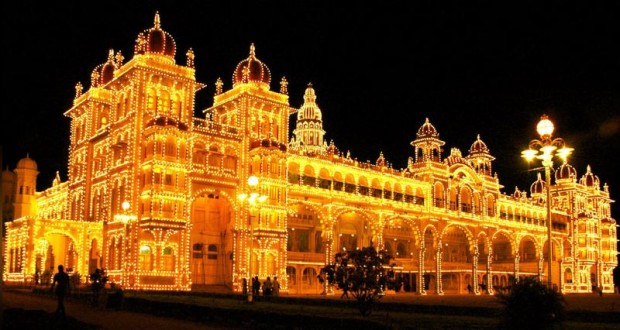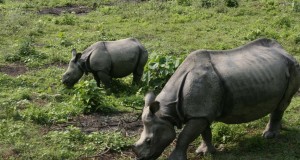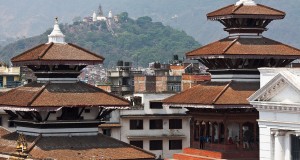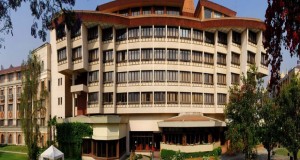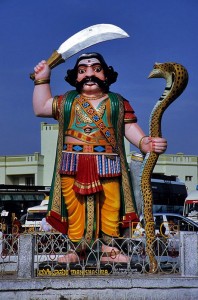 among the people in this area until destroyed by the goddess Chamunda. In the course of time, Mahishuru , town of Mahishasura, became ‘Mysore’, the cradle of many great dynasties in the South. During the rule of the Hoysalas, from the 12th to 14th centuries, art and architecture came to their peak resulting in the five famous sculptured temples of nearby Halebid, Belur and Somnathpur. Then, later in the 14th century, Mysore became the permanent capital of the Wodeyar Maharajahs. They lost it just once; to Hyder Ali in 1759, but regained it from the British after the death of Tipu Sultan in 1799. Under the protection of the Raj, the Maharajahs had nothing left to fear and went into palace-building in a big way. Yet the coming of Independence in 1947 spelt the end of their power, and of their many opulent palaces the finest, Amber Vilas, was turned into a museum, another into an art gallery, and three more into luxury hotels.The tourist revenue coming in from these establishments is sufficient to guarantee the present Maharajah just as rich a lifestyle as that of his predecessors. Like Bangalore, Mysore is at a fairly high altitude (770 m), giving it a pleasant climate throughout the year. It is most pleasant from September to January, but travellers drift in right up to May.
among the people in this area until destroyed by the goddess Chamunda. In the course of time, Mahishuru , town of Mahishasura, became ‘Mysore’, the cradle of many great dynasties in the South. During the rule of the Hoysalas, from the 12th to 14th centuries, art and architecture came to their peak resulting in the five famous sculptured temples of nearby Halebid, Belur and Somnathpur. Then, later in the 14th century, Mysore became the permanent capital of the Wodeyar Maharajahs. They lost it just once; to Hyder Ali in 1759, but regained it from the British after the death of Tipu Sultan in 1799. Under the protection of the Raj, the Maharajahs had nothing left to fear and went into palace-building in a big way. Yet the coming of Independence in 1947 spelt the end of their power, and of their many opulent palaces the finest, Amber Vilas, was turned into a museum, another into an art gallery, and three more into luxury hotels.The tourist revenue coming in from these establishments is sufficient to guarantee the present Maharajah just as rich a lifestyle as that of his predecessors. Like Bangalore, Mysore is at a fairly high altitude (770 m), giving it a pleasant climate throughout the year. It is most pleasant from September to January, but travellers drift in right up to May.
The best two months are September and October when the city is a post-monsoon spectacle of lush greenery and the 10-day festival of Dussehra takes place. This is the spectacular ‘festival of nine lights’, when many of the top musicians, dancers, and artists of Karnataka state turn up to give exhibitions and shows. It’s best to arrive on the last (10th) day of the festivities, when a victory procession of elephants, cavalry and (real) gold and silver coaches, accompanied by bands, floats and parading soldiers, celebrate Chamundi’s defeat of Mahishasura. Throughout October, the Maharajah’s Palace is illuminated nightly.
ARRIVAL/DEPARTURE
Air
Although Mysore has a small airfield the Vayudoot service is suspended at the time of writing.
Rail
From Mysore, there are trains to Bangalore (6/7 daily, 3 1/2 hours), to Goa (one train daily, changing at Londa Junction—from here, rather than wait many hours for a rail connection, proceed to Goa by bus), and to Bombay, Delhi and Calcutta.
Bus
The new Central bus-stand in Irwin Rd (north of Hotel Ritz) offers non-stop express buses to Bangalore (every 15 minutes; 3 hours) and Interstate buses to Ooty (scenic ride; 5 1/2 hours), to Cochin (one night bus, departing 9.30 pm; no advance-booking so arrive early to grab seats) and to Coimbatore (14 hours) for Trivandrum (another 4 hours, by train). There’s a useful cloakroom at the bus-stand where you can leave your bags if you’re only visiting Mysore for the day.

